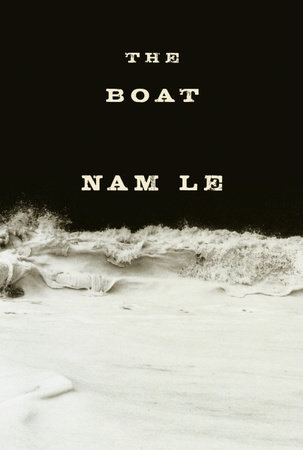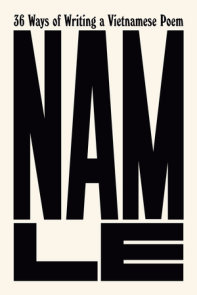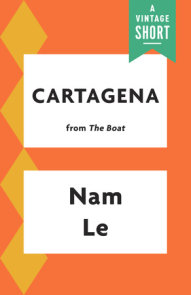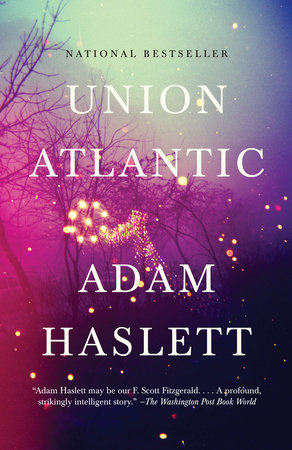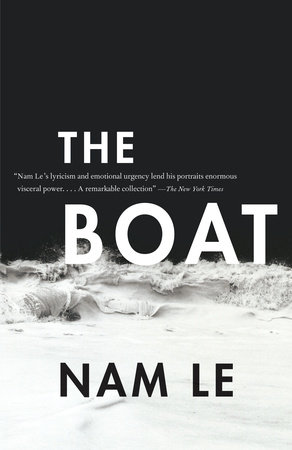

The Boat
By Nam Le
By Nam Le
By Nam Le
By Nam Le
Category: Short Stories
Category: Short Stories

-
$21.00
Aug 11, 2009 | ISBN 9780307388193
-
May 13, 2008 | ISBN 9780307269461
YOU MAY ALSO LIKE
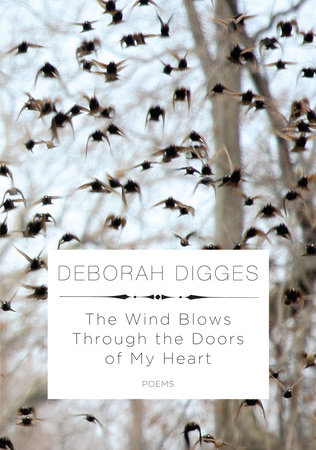
The Wind Blows Through the Doors of My Heart
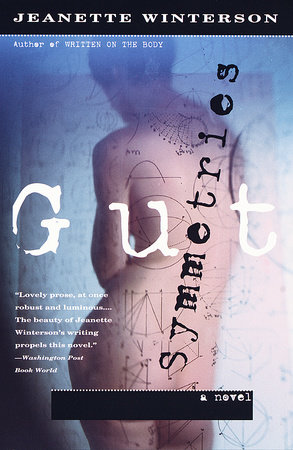
Gut Symmetries

Sand and Foam
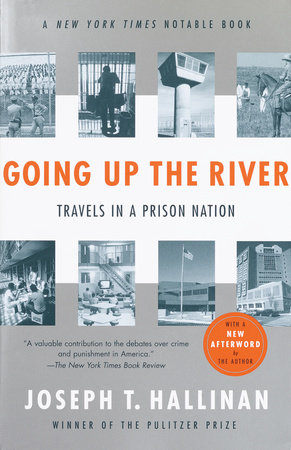
Going Up the River
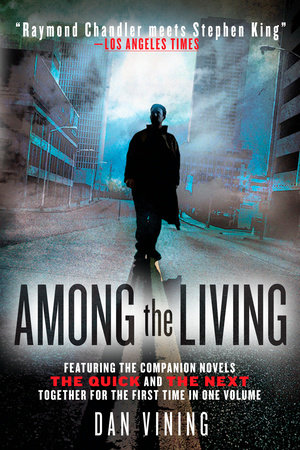
Among the Living
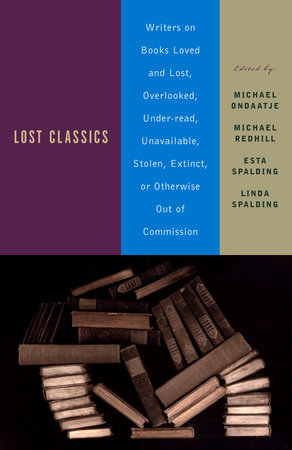
Lost Classics
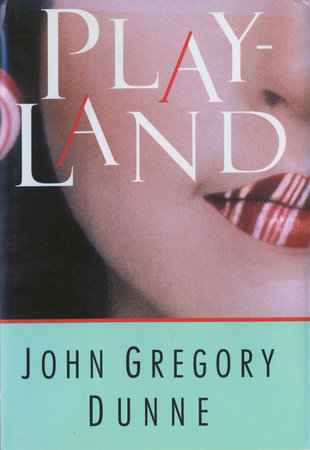
Playland
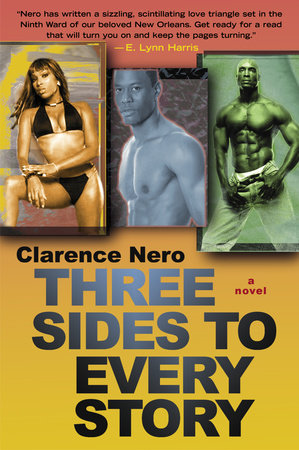
Three Sides to Every Story
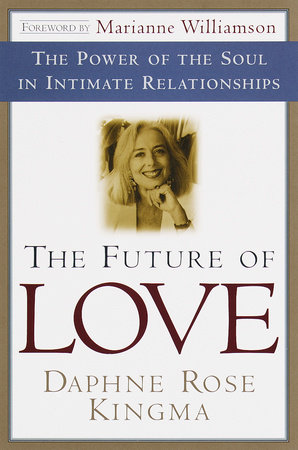
The Future of Love
Praise
“Nam Le’s lyricism and emotional urgency lend his portraits enormous visceral power. . . . A remarkable collection.” —The New York Times
“Nam Le is extraordinary, a writer who must – who will – be heard. . . .The Boat‘s vision and its power are timeless.” —Mary Gaitskill
“Astounding. . . . A refreshingly diverse and panoramic debut.” —Los Angeles Times Book Review
“Extraordinarily accomplished and sophisticated. . . . Moving and unforgettable.” —San Francisco Chronicle
“Wonderful stories that snarl and pant across our crazed world . . . . Nam Le is a heartbreaker, not easily forgotten.” —Junot Díaz
“Lyrical . . . Powerful and assured. . . . [Le’s] kaleidoscopic world view is on display throughout the stories, which seamlessly blend cultural traditions, accents and landscapes that run from lush to barren.” —The Miami Herald
“Stunning. . . .These stories are so beautifully written and cross emotional barriers of time and place with such clear vision and strong command of language we can only wonder with awe what Nam Le will offer us next.” —The Oregonian
“A collection that takes the reader across the globe. From Iowa to Colombia to Australia and Iran, the characters in Le’s stories each shape the world around them. In each story, the protagonists create a new atmosphere. . . .While Le is a writer who seems to be interested in the issues of the world, he is also a writer interested in the young. . . . Le does not downplay the lives of his children as fiction often does when portraying younger characters but presents them with a seriousness and intelligence that is refreshing. . . . The Boat is an impressive debut from a writer with a lot more to give. A writer to be remembered.” —Marion Frisby, The Denver Post
“Powerful . . . Lyrical . . . Devastating . . . A harsh and masterful effort, each tale a clean shot through the heart, the aim true. In seven stories covering six continents and an ocean, Le delivers a powerful and assured vision that offers a clear look at his impressive talents. . . . Le is the sort of writer who taps directly into the vein of desperation and offers no shelter. He’s not for the faint of heart, but the reward for soldiering on in the toughness of his world is the welcome recognition of a voice clear and brave.” —Amy Driscoll, The Miami Herald
“Captivating . . . An uncannily mature debut [that] distills time, experience . . . There’s a streak of the naturalist in Nam Le that looks back to such writers as Emile Zola, Stephen Crane and Theodore Dreiser. . . . It is a searing portrait of survival, love and sacrifice, which seems revelatory and wise. It is [Le’s] ethnic story that transcends ethnicity.” —Robert L. Pincus, San Diego Union-Tribune
“[The Boat] takes the reader from the South China Sea to Medellin, Colombia, to Tehran and beyond–places that, in many cases, Nam Le has never visited. . . . What struck me about [‘Tehran Calling’] was how vivid the imagery of the city of Tehran appears–the Shiite Ashura procession, with the self-flagellation, the rutted roads, [he] talks about the stale fluorescent writing at the airport . . . [Nam Le] writes so convincingly about these places [he’s] never been to . . .” —Guy Raz, correspondent, All Things Considered
“Brilliant . . . The Boat will quicken your pulse and awaken every nerve in your being. For avid readers who have hungered for stories that can transport them physically, intellectually and emotionally, stories so well-structured and narrated they appear to reinvent the form itself, the literary American Idol is Nam Le. [His] dynamic prose and remarkable range of subjects and points of view defy explanation. . . . There is so much to say about Nam Le’s genius that it would take a book and even that may not be enough. With The Boat, he defeats time, hollowness and cliché with every story, earning him the right to reap sheaves, buckets, reservoirs of generous, unabashed praise.” —Denise Gess, Raleigh News & Observer
“Twenty-nine-year-old Nam Le demonstrates the aesthetic ambition and sentence-making chops of a much more experienced writer. . . . Each moment of technical brio [in the opening story] deepens the dramatization of the all-but-unspeakable power of love between parent and child. By the end, any perceptive reader will agree that the ‘world could be shattered by a small stone dropped like a single syllable.’ . . . The plot unfolds with remorseless logic, harsh beauty, and an almost unbearable tenderness that reminded me of Dubliners. [The story’s] scenes [are] exact in their details and gorgeous in their musicality . . . I’ve been telling friends about The Boat for weeks now, saying ‘This guy’s got it.’ Now I’m telling you. Pass it on.” —John Repp, Cleveland Plain Dealer
“Astonishing . . . Not yet 30, Le effortlessly gives all seven tales in The Boat a different register, structure, vocabulary and tone.. . . . The miracle of these stories is how their author, by sleight of hand and virtue of skill, puts his searching, observant voice wherever he likes.” —John Freeman, Newark Star-Ledger
“Moving . . . The opening story in Nam Le’s debut collection, The Boat, is as dazzling an introduction to a writer’s work as I’ve read. . . . Nam Le digs beneath the surface and unfailingly sees the bundles as human in these accomplished stories about the terrible reverberations of violence.” —Heller McAlpin, The Christian Science Monitor
“It is uncommon that a writer’s first book can be described as masterful, especially when the author is not yet 30 years old. But The Boat, an extraordinary collection of seven short stories by Nam Le, is truly that kind of book. . . . As complex in its depth as it is accessible in its prose. . . . These stories are so beautifully written and cross emotional barriers of time and place with such clear vision and strong command of language we can only wonder with awe what Nam Le will offer us next.” —Jim Carmin, The Oregonian
“[The stories in Nam Le’s The Boat] flout the traditional maxim ‘Write what you know,’ taking on characters as diverse as Colombian drug lords, Iranian feminists, and a New York painter who sounds a lot like Lucian Freud. All sincere works of the imagination, these stories yet bear a self-conscious riposte to conventional wisdom. . . . Mr. Le stands out from the crowd [of debut writers] because of the breadth of his research and the confidence of his imagination. He may prize the universal, but he doesn’t skimp on concrete detail. In ‘Tehran Calling,’ for example, he could have described the row between an American visitor and her Iranian friend with dialogue and a few descriptions, but instead he takes us walking on the streets, describes smells, effects of lighting, and the fine points of street wear. . . . I found ‘Hiroshima,’ the most experimental story here, also to be one of the most absorbing. . . . There are many ticklish questions to ask about fiction and its sources, and they have been asked, recently, by many writers. Mr. Le’s distinction is to ask them without once seeming other than a hardworking practitioner of quality American lit.” —Benjamin Lytal, The New York Sun
“Leering. Sepia-toned. Dark. Dark. Dark. Light. Well-crafted. Intricately cut, sanded, steamed and stained. Striking. Aggressively schizophrenic. Crayola-esque (characters). Jim Shepard-esque (range).” —Esquire (All-Adjective Reviews)
“Sensational . . . There is something thrilling in discovering a gifted new writer on the American scene. And that is what we have in Nam Le, whose short story collection, The Boat, easily will be among the significant works of fiction published this year. . . . Stories that both crackle with immediacy and sport a cool, focused tone. His characters are drawn with an old master’s depth . . . It’s not often that a work of highbrow fiction moves like a suspense novel, but that’s the kind of talent Nam Le displays. It reaffirms your faith in literature. . . . There is a spare architecture to his sentences, yet he has the ability to create complex worlds, shadowed by bleakness and heartbreak. . . . His first story alternates between playful satire and dread seriousness, showing the kind of balancing act Le can pull off. [In] ‘Cartagena,’ Le vividly sketches the cardboard cities and muddy streets of Medellin . . . The story has the hypnotic power of a Graham Greene nightmare. . . . The book’s masterpiece is ‘Halflead Bay,’ an Aussie twist on Hemingway’s Nick Adams stories. . . . It is full of rich description, an ear for native lingo and keen observations of dysfunctional family dynamics. As you read the last lines of The Boat, it is not a stretch to flash on ‘The Dead,’ the legendary final story in Joyce’s Dubliners. . . . A book filled with grace, texture and humanity.” —Larry Aydlette, The Palm Beach Post
“The characters in Nam Le’s The Boat are impossible to pigeonhole, ranging from an egomaniacal Manhattan artist to a Colombian gangster to a hard-drinking Iowa M.F.A. student. [The] standout [is] the brutal title story [which] dramatizes the plight of three Vietnamese boat people. Le’s viscerally affecting writing and bold imagination mark an exciting debut.” —Jennifer Reese, Entertainment Weekly
“Stories [that] engulf you and transport you to another time, another place–give you a window into someone else’s soul almost deeper than if it were your own. . . . Long on character, depth and emotion: you’d swear that [Nam Le] has lived in every one of those stories [that make up The Boat]. When you finish each one, you will feel as if you have read a novel, your breathing will be heavy and your heart will be pounding as you return from a deeply personal adventure that has, in some strange way, become your own. . . . The thread tying the stories together in The Boat is the dramatic humanity, the poetic language, and most of all, the idea that that depth and intensity of human emotion is expressed on every continent. We are not so different after all.” —Faye Levow, Portsmouth Herald News
“Four stars . . . The stories [in The Boat] connect across country, class and circumstance–not only through Le’s ambition to nail each milieu, but through his obsession with the ways people live in and reveal their cultures . . . Each story immerses readers in its own distant setting. The book’s success isn’t just a matter of scene-setting; it also depends on Le’s characters and his classic, coincidences-explained-later plotting. He’ll make you marvel at the web his South American hit men are caught in, and he’ll make you worry for them. . . . In a piece about an Iranian activist and the clueless white friend who comes to visit her, he writes the part of the American interloper with sympathy and aplomb. . . . Le offers real insight.” —Sophie Fels, Time Out New York
“Seven stories set around the globe–from Iowa to Tehran, Manhattan to Australia, and Colombia to Hiroshima–make up Vietnam-born Nam Le’s dynamic debut collection, The Boat, in which achingly familiar alliances converge in ingeniously unlikely places.” —Lisa Shea, Elle
“Wide-ranging, knife-sharp stories by a masterly 29-year-old. Nam Le was born in Vietnam and raised in Australia, yet his debut collection of stories, The Boat, reveals as mature and certain an American voice as just about any native-born writer twice his age. His prose evokes Philip Roth’s–sure of itself, clean, and invisibly effective. These muscular and psychologically rich narratives take place in the United States, Australia, Colombia, and in a storm-tossed boat in the South China Sea [and] contend with a startlingly wide array of characters . . . What’s notable is the structural soundness of these powerful and far-ranging pieces: Each one is built to exactly the shape, and flows in exactly the tone and language, that will suit the needs of the story. The final and longest story in the book, ‘The Boat,’ takes on the deepest issues of life, love, and death, something worthy of Conrad or James. Nam Le is a remarkably sophisticated new writer.” —Vince Passaro, O, The Oprah Magazine
“Stories rooted in war and history [that] frequently zoom in on the affairs of characters who have to live with the consequences. . . . Le uses his wonderfully flexible prose style to explore Vietnamese ethnic identity, writing workshops, and even plain old drunkenness.” —Colin Marshall, The Santa Barbara Independent
“Stories [that] are reflective of their writer: eclectic, diverse, true in their toughness and giving in their complexity. . . . Two gems [are] ‘Love and Honor and Pity and Pride and Compassion and Sacrifice,’ [which] is art at its highest form, incorporating satire, metafiction, homage, and social critique into a story about a writer and his father and the infamous My Lai Massacre, [and] the title story ‘The Boat’ [which] is filled with so much emotional truth, it borders the line with non-fiction. . . . It turned a tale into an experience and brought us that much closer to one another.” —Ky-Phong Tran, Nguoi Viet Daily News
“[Nam Le’s] personal history is as compelling and engrossing as any of his writing. . . . A debut collection of seven taut, geographically diverse stories . . . Le could be the next big thing [and] the opening story, ‘Love and Honor and Pity and Pride and Compassion and Sacrifice,’ goes a good distance to proving it.” —Robert Birnbaum, The Morning News
“So engaging, so unequivocally well done, [The Boat] is sure to appeal to any fan of good writing. From the opening tale, it’s hard not to be giddy. [‘Love and Honor and Pity and Pride and Compassion and Sacrifice’] is a brilliantly self-conscious and humorous slice of the writing life, which doubles as a poignant story about fathers and sons and family tragedies. . . . Things only get better from there. Nam Le is a chameleon of voices and points of view, leading the reader through the experiences of an older man, a disillusioned young woman, a boy on the cusp of adulthood, and a teenage girl. The Boat takes us all over the world with fantastic verisimilitude. . . . ‘Halflead Bay’ is an enviable achievement–an adolescent’s battle to find courage as his life begins to turn upside down, the story developed with perfect suspense. . . . And the title story offers urgency, poignancy and heartbreaking tragedy. As if the stories themselves weren’t enough to make The Boat a worthy summer read, the skill of the author is a spectacle to behold. He manages to avoid so many pitfalls. He doesn’t shy away from stark and disturbing images, for example, yet he doesn’t rely on the grotesque to create effective writing. The reader can sense his personal investment in the work, but the stories aren’t even close to self-indulgent. It’s enough to give a person a literary crush. Each story is dark and deep, exquisitely constructed and beautifully told. Nam Le is a studied, competent and graceful writer, and The Boat is both a contemporary treasure and a harbinger of good things to come.” —Jessica Inman, BookPage
“The protagonist of the first story in this stellar debut collection is the Vietnam-born Nam, a former lawyer from Australia trying to meet a deadline at the Iowa Writers’ Workshop when his estranged father blows into town. Will this [collection] be a bunch of autobiographical stories exemplifying ‘ethnic fiction’ (which the story actually managed, rather slyly, to dismiss)? Absolutely not–unless Le is also a 14-year-old assassin in Colombia, asked to kill a friend; a crotchety if successful painter coming to terms with a cancer diagnosis just as the daughter he’s never met prepares for her Carnegie Hall debut; a high school boy in Australia who’s achieved a modest sports victory and must face down a bully as his mother faces death; and an American woman visiting a friend in Tehran who risks her life battling the regime. Le writes rawly rigorous stories that capture entire worlds; each character is distinctive and fully fleshed out, each plot eventful as a full-length novel but artfully compressed. Highly recommended.” —Barbara Hoffert, Library Journal
“[The Boat is] set on six continents and at sea, in the twentieth and twenty-first centuries, [with] characters ranging in age from childhood through the senior years. Many [of the stories] explore the intricate loyalties and betrayals in family life: notably, ‘Love and Honor and Pity and Pride and Compassion and Sacrifice,’ in which a Vietnamese Australian émigré studying at the University of Iowa’s writers’ program experiences his father’s final brutality, and ‘Halflead Bay,’ in which a teenage boy struggles with the father and brother who rescue him from a vicious schoolmate. [The characters] are brought to life in powerful stories of love and death through a muscular yet delicate style: lyrical, often poetic, leaving the obvious unsaid and endings ambiguous. Readers will devour this book.” —Ellen Loughran, Booklist
“A breathtakingly assured collection of stories–powerful, moving, unsparingly honest–exhibiting a narrative confidence and range that is as remarkable as it is mature. A tremendous debut.” —William Boyd, author of Any Human Heart
“From a Colombian slum to the streets of Tehran, seven characters in seven stories struggle with very particular Swords of Damocles in Pushcart Prize winner Le’s accomplished debut. . . . The opening [story] features a Vietnamese character named Nam who is struggling to complete his Iowa Writer’s Workshop master’s when his father comes for a tense visit . . . The story’s ironies are masterfully controlled by Le, and reverberate through the rest of this peripatetic collection. Taken together, the stories cover a vast geographic territory and are filled with exquisitely painful and raw moments of revelation, captured in an economical style as deft as it is sure.” —Publishers Weekly (starred review)
“A polished and intense debut of astonishing range. Some of the stories border on novellas, and this allows the author more latitude to develop the complexity of his characters. The opening story is a brilliantly conceived narrative about a writer called Nam . . . When his father, a Vietnamese immigrant interrupts both Nam’s schedule and his personal life, Nam begins to fret, for he’s worried about being able to produce a story on the tight deadline he faces. He’s not interested in falling back on the ‘typical’ survival story about Vietnamese boat people, and he remembers that at an earlier time his father confessed to having witnessed the My Lai massacre as a boy of 14. This revelation leads Nam to a stunning realization about the nature of father-son relationships, and his epiphany becomes the true subject of his story. . . Ironically, and slyly, with a nod to the opening story, the final piece, which gives the book its name, is an imaginative reconstruction for what it felt like to be a boat person, to launch into a 12-day journey with no foreseeable end. Consummately self-assured.” —Kirkus Reviews
“Stellar . . . The unusually various characters in Nam Le’s excellent debut collection live between worlds. . . . The book’s seven stories are also diverse in setting and mode. Consequently, the reader . . . becomes a participant in Le’s transglobal examination of lives being lived in mental and physical border zones. Le leaps from world to world with the help of his unusually supple prose. It can shift over the course of a page from intense, detailed understatement to the workmanlike to the searingly eloquent. The textures of prose found among the stories are equally distinct. . . . In The Boat’s opening story, Le’s fictional alter ego . . . [is] drafting a story, much like the one we are reading, that simultaneously enacts, dismantles, and expands on the genre. The Boat manages to breathe similarly fresh air into the overly familiar idea of the short-story collection. The result is bracing.” —Laird Hunt, Bookforum
“From the very first page of The Boat, Nam Le’s extraordinary talent, range of vision, and moral courage make the reader sit up and take notice. By the last page, one feels a kind of fervent gratitude–rare enough these days–for having been introduced to a young writer whose mark on the literary world, so freshly made, will only grow deeper in the years to come.” —John Burnham Schwartz, author of The Commoner and Reservation Road
“Nam Le writes with a rare blend of courage and beauty. His prose has a stunning clarity that works perfectly with the constant flow of narrative surprises. Book your passage on The Boat. You will not forget the people you meet on the voyage.” —Chris Offutt, author of The Same River Twice
“The Boat is tremendous, challenging and ambitious, worthy of the same shelf that holds Dubliners and The Things They Carried–like those works, it asks to be read as a whole and taken seriously as a book. In it, storms gather but no one seems able to respond; violence leads to confusion instead of clarity; love provokes rather than answers old questions, stirring up painful longings in numb and broken souls. The book journeys across time and space, history and continents, finding a nightmare of isolation, fear, upheaval and violence. Nam Le looks into our present, and we seem to hear a prophetic voice coming to us from the future, but really this book nails our collective now, our kairos, with an urgency and relevance that feels visionary.” —Charles D’Ambrosio, author of The Dead Fish Museum
“In the first story of this fine collection, Nam Le has already demonstrated the kind of courage and directness it takes most writers years to achieve. By the last, he’s proven he can take you on a journey to almost anywhere–the slums of Colombia, the South Asian seas, the exurbs of Australia, or the art world of New York–all in vivid and at times harrowing detail. The Boat is an impressive feat, and the debut of a very talented writer.” —Adam Haslett, author of You Are Not a Stranger Here
“In these seven fierce, alluring stories, Nam Le demonstrates, to an extraordinary degree, John Donne’s claim that no man is an island. I was impressed and deeply moved by the many worlds–Iowa City, war-torn Viet Nam, rural Australia–to which this brilliant young writer transported me. A terrific book.” —Margot Livesey, author of Eva Moves the Furniture
Awards
Anisfield-Wolf Book Award WINNER 2009
Dylan Thomas Prize WINNER 2008
Library Journal Best Books of the Year WINNER 2008
PEN/Malamud Award for Short Fiction WINNER 2010
21 Books You’ve Been Meaning to Read
Just for joining you’ll get personalized recommendations on your dashboard daily and features only for members.
Find Out More Join Now Sign In






